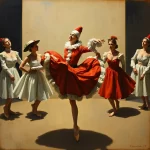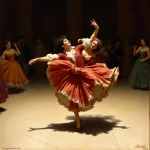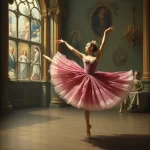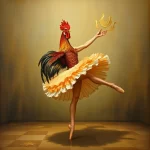Ballet: Pulcinella (Igor Stravinsky, 1920)

Introduction
Ballet: Pulcinella is a one-act ballet composed by Igor Stravinsky in 1920, with choreography by Léonide Massine. The ballet premiered on May 15, 1920, at the Paris Opera, under the auspices of Sergei Diaghilev’s Ballets Russes. Pulcinella is a vibrant and whimsical work that draws inspiration from the commedia dell’arte tradition, featuring a plot filled with love, deception, and humor.
Historical Background
Creation and Development
The creation of Pulcinella occurred during a period of significant artistic experimentation and collaboration in the early 20th century. The aftermath of World War I saw a resurgence of interest in classical forms and themes, often reinterpreted through a modern lens. Stravinsky, already renowned for his groundbreaking works like The Firebird and The Rite of Spring, was approached by Diaghilev to compose a ballet based on the music attributed to Giovanni Battista Pergolesi, an 18th-century Italian composer.
The inspiration for Pulcinella came from the commedia dell’arte, a form of theater characterized by masked “types” and improvised performances. The character of Pulcinella, a cunning and mischievous servant, is central to this tradition. The collaboration between Stravinsky, Massine, and Diaghilev was crucial in bringing this ballet to life, with each artist contributing their unique vision and expertise.
Premiere and Reception
Pulcinella premiered on May 15, 1920, at the Paris Opera. The initial reception was mixed, with some critics praising the innovative fusion of classical and modern elements, while others were less enthusiastic about the departure from Stravinsky’s earlier, more avant-garde works. Despite the varied critical response, the ballet quickly gained popularity and became a staple in the Ballets Russes repertoire.
Notable early performances included revivals by the Ballets Russes and other prominent ballet companies, solidifying Pulcinella‘s place in the ballet canon.
Synopsis of the Ballet
Pulcinella is a one-act ballet that unfolds in a series of lively and humorous scenes. The plot revolves around the character of Pulcinella, who finds himself entangled in a web of romantic misunderstandings and deceptions.
Detailed Summary
The ballet opens with Pulcinella courting the beautiful Pimpinella. However, their romance is complicated by the arrival of two suitors, Florindo and Cloviello, who also vie for Pimpinella’s affection. Pulcinella’s cleverness and trickery come to the fore as he navigates the challenges posed by his rivals.
In a series of comedic episodes, Pulcinella disguises himself and orchestrates a series of deceptions to outwit Florindo and Cloviello. The ballet features a masquerade ball, mistaken identities, and humorous confrontations, all set to Stravinsky’s vibrant and playful score.
The climax of the ballet occurs when Pulcinella fakes his own death to escape his pursuers. Believing him to be dead, the other characters mourn his loss, only for Pulcinella to reveal himself alive and well, much to their astonishment and relief. The ballet concludes with a joyful celebration, as Pulcinella and Pimpinella are finally united.
Musical Composition
Composer’s Role
Igor Stravinsky’s contribution to Pulcinella is a masterful reimagining of Pergolesi’s music. Stravinsky took existing pieces attributed to Pergolesi and other composers of the period, reorchestrating and infusing them with his distinctive style. The result is a score that blends Baroque elegance with modern sensibilities, characterized by its rhythmic vitality and inventive orchestration.
Musical Themes and Motifs
The music of Pulcinella features recurring themes and motifs that enhance the narrative and emotional arc of the ballet. Stravinsky’s use of light, dance-like rhythms and playful melodies reflects the comedic and whimsical nature of the story. The score includes notable pieces such as the “Overture,” “Serenata,” and “Tarantella,” each contributing to the overall charm and character of the ballet.
Famous Recordings and Performances
Several iconic recordings of Pulcinella have been made over the years, showcasing the enduring appeal of Stravinsky’s score. Notable performances include those conducted by Stravinsky himself, as well as recordings by renowned conductors such as Pierre Boulez and Leonard Bernstein. These recordings capture the vibrant energy and intricate details of the music, making them essential listening for fans of the ballet.
Choreography and Dance
Choreographer’s Vision
Léonide Massine’s choreography for Pulcinella is a brilliant fusion of classical ballet technique and the expressive, exaggerated movements of commedia dell’arte. Massine’s interpretation emphasizes the comedic and theatrical aspects of the story, with lively, character-driven dances that bring the characters to life.
Signature Dance Numbers
Key dance numbers in Pulcinella include the “Pas de Deux” between Pulcinella and Pimpinella, which showcases their romantic chemistry, and the “Tarantella,” a lively group dance that captures the festive spirit of the ballet. Massine’s choreography is notable for its use of mime and exaggerated gestures, reflecting the influence of commedia dell’arte.
Notable Interpretations
Over the years, different productions of Pulcinella have brought unique interpretations to the choreography. Some have emphasized the ballet’s comedic elements, while others have focused on its romantic or dramatic aspects. Notable interpretations include those by choreographers such as George Balanchine and Jerome Robbins, each bringing their distinct style to the work.
Characters and Roles
Main Characters
- Pulcinella: The clever and mischievous protagonist, known for his cunning and resourcefulness.
- Pimpinella: Pulcinella’s love interest, a beautiful and spirited young woman.
- Florindo: One of Pimpinella’s suitors, who competes with Pulcinella for her affection.
- Cloviello: Another suitor of Pimpinella, also vying for her love.
Supporting Characters
- Prudenza: A friend of Pimpinella, who becomes involved in the romantic entanglements.
- Rosetta: Another friend of Pimpinella, adding to the comedic confusion.
- Furbo: A character who assists Pulcinella in his schemes.
Famous Dancers
Notable dancers who have portrayed the roles in Pulcinella include Léonide Massine himself, who originated the role of Pulcinella, as well as celebrated dancers such as Rudolf Nureyev and Mikhail Baryshnikov. Their performances have contributed to the ballet’s enduring legacy.
Cultural and Artistic Impact
Influence on Ballet and Dance
Pulcinella has had a significant influence on the development of ballet and dance. Its innovative blend of classical and modern elements paved the way for future choreographers to explore new forms of expression. The ballet’s use of commedia dell’arte also inspired other works that draw on theatrical traditions.
Cultural Significance
The ballet’s place in popular culture is evident in its continued presence in the repertoires of major ballet companies. Pulcinella has also been referenced in literature, theater, and other media, highlighting its broad cultural impact.
Legacy and Revivals
Major revivals of Pulcinella have been staged by companies such as the New York City Ballet and the Royal Ballet, each bringing fresh interpretations to the work. The ballet continues to be performed and celebrated today, testament to its enduring appeal and significance.
Iconic Productions
Historic Productions
Historic productions of Pulcinella include the original Ballets Russes performances, which featured innovative set and costume designs by Pablo Picasso. These early productions set the standard for future interpretations of the ballet.
Contemporary Productions
Recent productions of Pulcinella have explored new approaches to the choreography and design, often incorporating modern elements while staying true to the spirit of the original. These contemporary interpretations highlight the ballet’s versatility and timelessness.
Production Design
The set, costume, and lighting design in various productions of Pulcinella have played a crucial role in bringing the story to life. Picasso’s original designs are particularly notable for their bold, abstract style, which complemented the ballet’s playful and whimsical nature.
Critical Reception and Reviews
Initial Critical Response
The initial critical response to Pulcinella was mixed, with some critics praising its innovative fusion of classical and modern elements, while others were less enthusiastic about the departure from Stravinsky’s earlier, more avant-garde works. Despite this, the ballet quickly gained popularity and became a staple in the Ballets Russes repertoire.
Modern Reviews
Contemporary critics and audiences continue to appreciate Pulcinella for its charm, humor, and inventive choreography. The ballet’s enduring popularity is a testament to its timeless appeal and the genius of its creators.
Fun Facts and Trivia
Behind-the-Scenes Stories
One interesting anecdote from the production of Pulcinella involves Stravinsky’s initial reluctance to work with Pergolesi’s music. However, Diaghilev convinced him by emphasizing the creative freedom he would have in reimagining the pieces.
Notable Performers
Famous dancers associated with Pulcinella include Léonide Massine, who originated the role of Pulcinella, and later stars such as Rudolf Nureyev and Mikhail Baryshnikov, who brought their unique interpretations to the character.
Trivia
- Stravinsky’s score for Pulcinella includes a hidden tribute to his teacher, Nikolai Rimsky-Korsakov, in the form of a musical quotation.
- The ballet’s original set and costume designs were created by Pablo Picasso, adding a unique visual element to the production.
Conclusion
Summary of the Ballet’s Importance
Pulcinella is a significant work in the world of ballet, known for its innovative fusion of classical and modern elements, its vibrant and playful score, and its inventive choreography. The collaboration between Stravinsky, Massine, and Diaghilev resulted in a timeless masterpiece that continues to captivate audiences.
Final Thoughts
Pulcinella remains a beloved and influential work in the ballet repertoire. Its enduring appeal lies in its ability to blend humor, romance, and theatricality with artistic innovation. For those who have not yet experienced this delightful ballet, it is highly recommended to watch a performance or listen to Stravinsky’s enchanting score.
FAQ
What is the central theme of this ballet?
The central theme of Pulcinella is the comedic and romantic entanglements of its characters, set against the backdrop of the commedia dell’arte tradition.
Who are the main characters in this ballet?
The main characters in Pulcinella are Pulcinella, Pimpinella, Florindo, and Cloviello.
What is the most famous dance number in this ballet?
One of the most famous dance numbers in Pulcinella is the “Tarantella,” a lively group dance that captures the festive spirit of the ballet.
How long does a typical performance of this ballet last?
A typical performance of Pulcinella lasts approximately 35-40 minutes.
Are there any modern adaptations of this ballet?
Yes, there have been several modern adaptations and revivals of Pulcinella, each bringing fresh interpretations to the choreography and design.
Why is this ballet considered important in the history of dance?
Pulcinella is considered important in the history of dance for its innovative blend of classical and modern elements, its vibrant score by Stravinsky, and its inventive choreography by Massine. It has had a lasting influence on the development of ballet and continues to be celebrated today.





